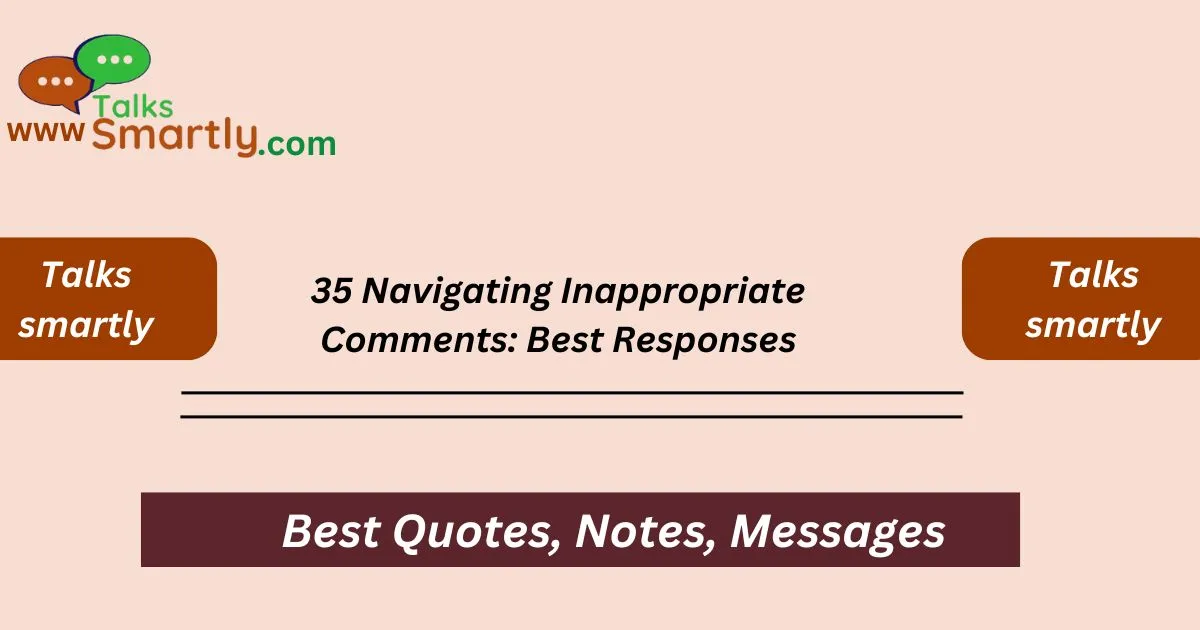“Mastering the art of responding to inappropriate comments can empower you in social interactions.”
In today’s world, inappropriate comments can surface in various situations, whether in person or online. From backhanded compliments to unwanted personal inquiries, knowing how to respond can help maintain your dignity and composure.
This blog post explores effective responses to inappropriate comments, empowering you to handle such situations with grace. Sometimes, it’s challenging to know how to respond to inappropriate remarks without escalating tension.
By mastering the art of effective communication, you can transform uncomfortable exchanges into opportunities for growth and understanding. We encourage you to reflect on your experiences and consider how you might respond differently in the future.
Understanding how to navigate inappropriate comments can improve not only your communication skills but also your relationships. Responding effectively can protect your self-esteem and reinforce boundaries.
This blog post will equip you with 35 best responses to inappropriate comments, offering practical examples to help you confidently address such situations.
35 Navigating Inappropriate Comments: Best Responses
- “That’s not appropriate.”
- “Let’s keep the conversation respectful.”
- “I don’t appreciate that comment.”
- “Could you clarify what you mean?”
- “That’s not a helpful remark.”
- “I’d prefer if we didn’t discuss that.”
- “Let’s change the subject.”
- “I think that was out of line.”
- “Please don’t say things like that.”
- “That’s a personal question.”
- “I’m uncomfortable with that.”
- “Can we keep things professional?”
- “That could be hurtful to some.”
- “I’d like to keep this conversation positive.”
- “Your comment seems dismissive.”
- “I don’t think that’s fair to say.”
- “That’s not a joke I find funny.”
- “I think we should respect each other’s boundaries.”
- “That could be taken the wrong way.”
- “I’d rather not discuss that.”
- “That’s not your place to say.”
- “Let’s focus on something more constructive.”
- “That was unexpected.”
- “I don’t think that’s an appropriate topic.”
- “I prefer to keep my personal life private.”
- “Let’s stick to neutral topics.”
- “That’s not something I’m comfortable sharing.”
- “I believe that’s disrespectful.”
- “I’m not sure what you meant by that.”
- “Let’s not make assumptions.”
- “Can we avoid comments like that?”
- “I think you should reconsider what you just said.”
- “I don’t want to discuss my life in that way.”
- “Let’s move on from that comment.”
- “I prefer to focus on positive conversations.”
1. “That’s not appropriate.”
When someone makes an inappropriate comment, responding directly can set clear boundaries. You can say, “That’s not appropriate.” This straightforward response communicates your discomfort and prompts the speaker to reflect on their words.
Example: If a colleague makes a sexist joke at work, saying, “That’s not appropriate,” lets them know their comment is unacceptable.
2. “Let’s keep the conversation respectful.”
This phrase encourages a more courteous dialogue and reminds the other person that respect is essential. By saying, “Let’s keep the conversation respectful,” you steer the discussion back to a more positive tone.
Example: If a friend starts making fun of another’s appearance, you can interject with, “Let’s keep the conversation respectful,” to defuse the situation.
3. “I don’t appreciate that comment.”
Expressing your feelings can make the other person reconsider their words. When you say, “I don’t appreciate that comment,” it shows that their remark was hurtful or inappropriate.
Example: If someone makes a negative remark about your work, respond with, “I don’t appreciate that comment,” to indicate that their criticism is unwarranted.
4. “Could you clarify what you mean?”
Asking for clarification can put the person on the spot and make them reconsider their wording. By saying, “Could you clarify what you mean?” you challenge the appropriateness of their comment.
Example: If someone makes an ambiguous remark about your lifestyle, asking for clarification can prompt them to rethink their words.
5. “That’s not a helpful remark.”
This response highlights the unconstructive nature of their comment and encourages them to think before speaking. Saying, “That’s not a helpful remark,” can redirect the conversation towards more productive topics.
Example: If a team member dismisses your idea with a snarky comment, respond with, “That’s not a helpful remark,” to promote constructive feedback.
6. “I’d prefer if we didn’t discuss that.”

Setting boundaries is essential in maintaining respectful conversations. By stating, “I’d prefer if we didn’t discuss that,” you assert your comfort levels without being confrontational.
Example: If a friend starts gossiping about another mutual friend, saying, “I’d prefer if we didn’t discuss that,” effectively halts the conversation.
7. “Let’s change the subject.”
If you find a topic uncomfortable, suggesting a change can be a polite way to redirect the conversation. Saying, “Let’s change the subject,” allows you to regain control of the discussion.
Example: If a discussion turns to politics and becomes heated, you might say, “Let’s change the subject,” to find a more agreeable topic.
8. “I think that was out of line.”
This direct statement signals to the speaker that their comment was inappropriate. By saying, “I think that was out of line,” you assert your disapproval clearly.
Example: If someone makes a rude joke about your background, you can respond with, “I think that was out of line,” making it clear you won’t tolerate disrespect.
9. “Please don’t say things like that.”
This request emphasizes your discomfort and asks the other person to reconsider their approach. Saying, “Please don’t say things like that,” can serve as a wake-up call for the speaker.
Example: If a coworker makes an insensitive comment about your attire, responding with, “Please don’t say things like that,” encourages them to be more thoughtful.
10. “That’s a personal question.”
When faced with invasive questions, highlighting their personal nature can deter further probing. By stating, “That’s a personal question,” you signal that some topics are off-limits.
Example: If someone asks about your salary, responding with, “That’s a personal question,” clearly indicates your boundaries.
11. “I’m uncomfortable with that.”
Expressing discomfort can be a powerful way to communicate your feelings. By saying, “I’m uncomfortable with that,” you let the speaker know their comment affected you negatively.
Example: If a friend makes a suggestive joke, replying with, “I’m uncomfortable with that,” can help them understand the impact of their words.
12. “Can we keep things professional?”
In a work setting, maintaining professionalism is vital. By asking, “Can we keep things professional?” you redirect the conversation back to appropriate topics.
Example: If a colleague starts discussing personal matters during a meeting, you can say, “Can we keep things professional?” to steer the conversation.
13. “That could be hurtful to some.”
Highlighting the potential impact of a comment can encourage empathy. By saying, “That could be hurtful to some,” you remind the speaker to be mindful of others’ feelings.
Example: If someone makes a joke about a sensitive topic, you can say, “That could be hurtful to some,” to promote sensitivity.
Best Responses to “Did I Do Something Wrong?”
14. “I’d like to keep this conversation positive.”
Emphasizing positivity can help maintain an uplifting atmosphere. By stating, “I’d like to keep this conversation positive,” you guide the dialogue toward more encouraging subjects.
Example: If someone starts criticizing others, you can interject with, “I’d like to keep this conversation positive,” to change the tone.
15. “Your comment seems dismissive.”
Pointing out dismissive remarks encourages better communication. By saying, “Your comment seems dismissive,” you confront the speaker’s attitude without being aggressive.
Example: If a colleague brushes off your idea, responding with, “Your comment seems dismissive,” calls attention to their behavior.
16. “I don’t think that’s fair to say.”
This response indicates that the comment was unjust and encourages reflection. By saying, “I don’t think that’s fair to say,” you assert your disagreement with their opinion.
Example: If a friend makes a broad statement about a group of people, you can say, “I don’t think that’s fair to say,” to challenge their view.
17. “That’s not a joke I find funny.”
If someone makes an inappropriate joke, stating your disapproval can signal a need for change. By saying, “That’s not a joke I find funny,” you make it clear that their humor isn’t appreciated.
Example: If someone cracks a joke at another’s expense, replying with, “That’s not a joke I find funny,” can discourage such behavior in the future.
18. “I think we should respect each other’s boundaries.”
Reinforcing the importance of boundaries can help create a respectful environment. By stating, “I think we should respect each other’s boundaries,” you remind everyone to be considerate.
Example: If someone continually makes inappropriate comments, you can say, “I think we should respect each other’s boundaries,” to emphasize the need for respect.
19. “That could be taken the wrong way.”
Highlighting the potential for misinterpretation can help the speaker rethink their words. By saying, “That could be taken the wrong way,” you signal the need for caution in their comments.
Example: If someone makes a sarcastic remark that could be offensive, responding with, “That could be taken the wrong way,” encourages more thoughtful communication.
20. “I’d rather not discuss that.”
Setting a clear boundary can effectively redirect a conversation. By stating, “I’d rather not discuss that,” you assert your preference without being confrontational.
Example: If someone brings up a controversial topic at dinner, you might respond with, “I’d rather not discuss that,” to steer the conversation elsewhere.
21. “That’s not your place to say.”
This statement asserts your authority over your own life and choices. By saying, “That’s not your place to say,” you emphasize that the speaker has overstepped their bounds.
Example: If a family member offers unsolicited advice about your relationship, replying with, “That’s not your place to say,” reestablishes your boundaries.
22. “Let’s focus on something more constructive.”
Encouraging constructive dialogue can foster a more positive environment. By saying, “Let’s focus on something more constructive,” you redirect the conversation toward productive topics.
Example: If a conversation devolves into criticism, you might say, “Let’s focus on something more constructive,” to encourage problem-solving instead.
23. “That was unexpected.”
Acknowledging the comment as surprising can serve to highlight its inappropriateness. By stating, “That was unexpected,” you indicate that the comment was not only inappropriate but also caught you off guard.
Example: If a coworker makes a shocking remark during a meeting, saying, “That was unexpected,” helps to address the awkwardness.
24. “I don’t think that’s an appropriate topic.”
This statement sets a clear boundary regarding acceptable conversation topics. By saying, “I don’t think that’s an appropriate topic,” you effectively indicate what is not suitable for discussion.
Example: If someone brings up a sensitive issue in a group setting, you can respond with, “I don’t think that’s an appropriate topic,” to redirect the conversation.
25. “I prefer to keep my personal life private.”
Establishing personal boundaries is essential for comfort. By stating, “I prefer to keep my personal life private,” you clarify your stance on discussing personal matters Navigating Inappropriate Comments.
Example: If someone pries into your relationship status, responding with, “I prefer to keep my personal life private,” sets a clear boundary.
26. “Let’s stick to neutral topics.”
Promoting neutral subjects can help maintain a respectful atmosphere. By saying, “Let’s stick to neutral topics,” you steer the conversation away from sensitive areas.
Example: If a discussion becomes heated, you might say, “Let’s stick to neutral topics,” to foster a calmer dialogue.
27. “That’s not something I’m comfortable sharing.”

Expressing your comfort levels can deter further questioning. By stating, “That’s not something I’m comfortable sharing,” you make your boundaries clear.
Example: If someone asks about your salary, responding with, “That’s not something I’m comfortable sharing,” effectively shuts down the conversation Navigating Inappropriate Comments.
28. “I believe that’s disrespectful.”
Addressing disrespect directly can prompt a change in behavior. By saying, “I believe that’s disrespectful,” you call out the inappropriate comment and encourage respect.
Example: If a colleague makes a rude remark about another’s work, you can reply, “I believe that’s disrespectful,” to advocate for a more respectful atmosphere.
29. “I’m not sure what you meant by that.”
Asking for clarification can prompt the speaker to rethink their words. By saying, “I’m not sure what you meant by that,” you encourage them to reconsider their phrasing.
Example: If a friend makes a vague comment about your choices, replying with, “I’m not sure what you meant by that,” allows them to clarify their intent Navigating Inappropriate Comments.
30. “Let’s not make assumptions.”
Encouraging open-mindedness can lead to better communication. By stating, “Let’s not make assumptions,” you advocate for understanding rather than judgment.
Example: If someone assumes something about your lifestyle, you can say, “Let’s not make assumptions,” to promote a more inclusive dialogue Navigating Inappropriate Comments.
31. “Can we avoid comments like that?”
This request emphasizes the need for respect in conversations. By saying, “Can we avoid comments like that?” you call for a more considerate approach.
Example: If a group member makes an insensitive joke, responding with, “Can we avoid comments like that?” helps reinforce respectful communication Navigating Inappropriate Comments.
32. “I think you should reconsider what you just said.”
This statement encourages reflection on the appropriateness of their comments. By saying, “I think you should reconsider what you just said,” you challenge them to think before speaking.
Example: If a friend makes an off-color remark, you can say, “I think you should reconsider what you just said,” to prompt reflection.
33. “I don’t want to discuss my life in that way.”
Setting a clear boundary can deter inappropriate questions. By stating, “I don’t want to discuss my life in that way,” you assert your preference for privacy.
Example: If someone starts questioning your personal choices in a judgmental tone, you might say, “I don’t want to discuss my life in that way,” to shut down the conversation Navigating Inappropriate Comments.
34. “Let’s move on from that comment.”
Encouraging a shift in conversation can help maintain a positive environment. By saying, “Let’s move on from that comment,” you redirect the discussion toward more appropriate topics.
Example: If a discussion takes a negative turn, you can interject with, “Let’s move on from that comment,” to reestablish a positive tone.
35. “I prefer to focus on positive conversations.”
Promoting positivity can foster a more constructive environment. By stating, “I prefer to focus on positive conversations,” you encourage uplifting dialogue.
Example: If someone starts complaining about work, you might say, “I prefer to focus on positive conversations,” to encourage a more hopeful discussion.
Key Insight About Inappropriate Comments
1. What should I do if someone makes an inappropriate comment?
Start by expressing your discomfort or addressing the comment directly. Use one of the responses outlined above.
2. How can I remain calm when responding to inappropriate remarks?
Take a deep breath and pause before responding. This can help you gather your thoughts and respond thoughtfully Navigating Inappropriate Comments.
3. Are there any responses that work best in a professional setting?
Yes, responses like “Can we keep things professional?” or “I’d like to keep this conversation positive” are effective in workplace situations.
4. How can I prevent inappropriate comments in the future?
Set clear boundaries and communicate your preferences openly with others to create a respectful atmosphere.
5. What if the person making the comment is a close friend?
It’s essential to communicate openly with friends. Use responses that encourage understanding, like “I’m uncomfortable with that” or “Let’s change the subject.”
Conclusion
Navigating inappropriate comments can be challenging, but it’s essential to respond effectively to maintain respectful interactions.
By using the responses outlined in this article, you can assert your boundaries and foster a more positive environment. Remember, it’s okay to express your discomfort and promote respectful dialogue, whether in a professional setting or among friends.











